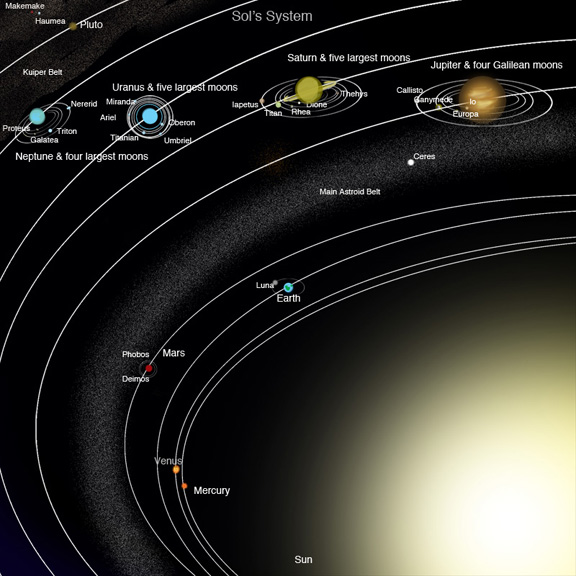Solar System
(Image not to scale)Sol is a yellow-orange, main sequence dwarf star GV-2.
|
Planet b (Mercury) With a slow rotation, a day on mercury lasts approximately 59 Earth days. Planet c (Venus) Diameter of 12,103 kilometers, covered in a dense atmosphere of sulfuric acid and carbon dioxide with an average temp of 467 C. Planet d (Earth) This is where human life is known to have evolved though some theorize that life may have evolved on Mars first and Martians seeded Earth. Approximately 70% of surface covered in liquid oceans. One regular moon. Planet e (Mars) 6792 kilometers in diameter. Often referred to as the "Red Planet" because its surface rocks and soil are colored by oxidized iron minerals. Two irregular moons. Due to it's closeness, Mars is the scene of many Earth vids and stories. Planet f (Jupiter) Diameter of 142,800 km but more than twice as massive as all the other planets combined. Jupiter's atmosphere has fast winds blowing in opposite directions in adjacent wide bands of latitude. It has a thin ring system and over 60 moons. Planet g: (Saturn) 120,000 km in diameter but the lowest average density of Sol's planets. It is flattened at the poles due to a very fast rotation. Saturn has icy rings which can be seen from Earth and moons counted anywhere between 60 and 200 depending on who is asked. Planet h (Uranus) diameter is 51,100 km planet completes a fast rotation in only 17 and a half hours. Unlike the other planets, its axis of rotation is north to south. It has 27 moons. Planet i (Neptune) Slightly smaller and denser than Uranus, it has a diameter of over 49,500 km )It has 13 moons Both Uranus and Neptune appear to be composed of mostly "ices" and rock, with about 15 percent hydrogen and a little helium. |